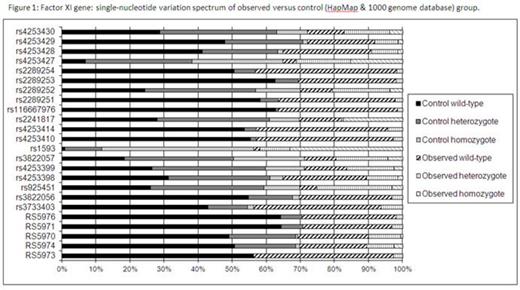Abstract
Introduction: In plasma, factor XI (FXI) circulates as a homodimeric precursor of a serine protease (FXIa), which plays an essential role in the contact activation of coagulation through the conversion of FIX to FIXa in a calcium-dependent manner. Each FXI monomer contains a heavy chain and a light chain that are joined together by disulphide bonds. The heavy chain contains all four apple domains and the light chain contains the serine protease domain. The fourth apple domain is necessary for dimerization.
The gene for FXI is located on the long arm of chromosome 4 (4q35) and contains 15 exons and 14 introns. To date, more than 240 mutations have been reported (http://www.factorxi.org). The prevalence of FXI deficiency in Caucasians is reported as low, but might be underestimated. Women with low FXI levels (<70%) are prone to excessive bleeding during menstruation. However, bleeding manifestations are not well correlated with the plasma FXI levels and bleeding episodes can vary widely among patients with similar low FXI levels.
In our previous study (Knol et al, AJOG, 2013), we found 4% FXI deficiency (< 70%) in unselected Dutch women with heavy menstrual bleeding (HMB). We also found that patients had significantly longer APTT compared to controls (26.5 vs 25.0 sec; p=0.001), despite higher levels of factor VIII. This turned out to be caused by lower median levels of FXI (100 vs 124 IU/dL; p<0.001).
These lower levels of FXI and increased bleeding tendency could be caused by the presence of specific single-nucleotide variants in the FXI gene in women with HMB.
To our knowledge, systemic analysis of FXI gene variants in women with HMB has not been reported.
Aim: to determine the single-nucleotide variants of the FXI gene in women with heavy menstrual bleeding.
Methods: the study was approved by the Institutional Review Board of the University Medical Center of Groningen. Informed consent was obtained from all patients. We included patients referred for heavy menstrual bleeding (PBAC-score >100). We measured the Tosetto bleeding score by questionnaire.
FXI activity levels were determined by an one-stage clotting assay (Siemens, Marburg, Germany). Reference interval was 65-150%. Direct sequencing analysis of all 15 exons and flanking introns of the factor XI gene was performed to detect single-nucleotide variants. Results were compared with the HapMap and 1000 genome database using the Fisher exact probability test on a 2x3 contingency table. In addition, we tested each single-nucleotide variant for Hardy-Weinberg equilibrium.
Results: We included 49 patients. Median FXI level was 96% (range 61%-155%). We found 31 different single-nucleotide variants in 49 patients with HMB. Seven out of 31 could not be compared to the control group due to small numbers, unknown frequency, or absence from the database. From the remaining 24 single-nucleotide variants (Figure 1), two (rs925451 and rs2241817) showed a significant difference compared to the control group (P<0.01). These two single-nucleotide variants showed also a significant departure from the Hardy-Weinberg equilibrium (P<0.01). There was no correlation between the number of single-nucleotide variants and the FXI level, PBAC-score or bleeding score.
Conclusions: Our study provides a detailed analysis of single-nucleotide variants of the factor XI gene. Among these 31 variants, rs925451 and rs2241817 seem to be associated with heavy menstrual bleeding.Overall, these data may serve as reference group for future studies on the molecular background of factor XI deficiency and heavy menstrual bleeding.
No relevant conflicts of interest to declare.
Author notes
Asterisk with author names denotes non-ASH members.


This feature is available to Subscribers Only
Sign In or Create an Account Close Modal